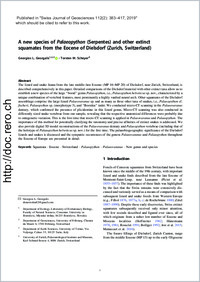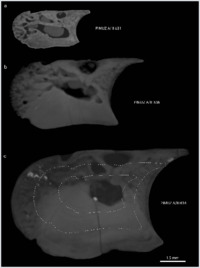A new species of Palaeopython (Serpentes) and other extinct squamates from the Eocene of Dielsdorf (Zurich, Switzerland)
- Georgalis, Georgios L. Department of Ecology, Laboratory of Evolutionary Biology, Faculty of Natural Sciences, Comenius University in Bratislava, Slovakia - Department of Geosciences, University of Fribourg, Switzerland - Department of Earth Sciences, University of Torino, Italy
- Scheyer, Torsten M. University of Zurich, Palaeontological Institute and Museum, Zurich, Switzerland
-
01.12.2019
Published in:
- Swiss Journal of Geosciences. - 2019, vol. 112, no. 2, p. 383–417
English
The lizard and snake fauna from the late middle–late Eocene (MP 16–MP 20) of Dielsdorf, near Zurich, Switzerland, is described comprehensively in this paper. Detailed comparisons of the Dielsdorf material with other extinct taxa allow us to establish a new species of the large “booid” genus Palaeopython, i.e., Palaeopython helveticus sp. nov., characterized by a unique combination of vertebral features, most prominently a highly vaulted neural arch. Other squamates of the Dielsdorf assemblage comprise the large lizard Palaeovaranus sp. and as many as three other taxa of snakes, i.e., Palaeopython cf. fischeri, Palaeopython sp. (morphotype 3), and “Booidea” indet. We conducted micro-CT scanning in the Palaeovaranus dentary, which confirmed the presence of plicidentine in this lizard genus. Micro-CT scanning was also conducted in differently sized snake vertebrae from our sample, revealing that the respective anatomical differences were probably due to ontogenetic variation. This is the first time that micro-CT scanning is applied in Palaeovaranus and Palaeopython. The importance of this method for potentially clarifying the taxonomy and precise affinities of extinct snakes is addressed. We also provide digital 3D model reconstructions of the Palaeovaranus dentary and Palaeopython vertebrae (including that of the holotype of Palaeopython helveticus sp. nov.) for the first time. The palaeobiogeographic significance of the Dielsdorf lizards and snakes is discussed and the sympatric occurrences of the genera Palaeovaranus and Palaeopython throughout the Eocene of Europe are presented in detail.
- Faculty
- Faculté des sciences et de médecine
- Department
- Département de Géosciences
- Language
-
- English
- Classification
- Palaeontology
- License
- License undefined
- Identifiers
-
- RERO DOC 327999
- DOI 10.1007/s00015-019-00341-6
- Persistent URL
- https://folia.unifr.ch/unifr/documents/308298
Other files
Statistics
Document views: 70
File downloads:
- geo_nsp.pdf: 267
- geo_nsp_sm.pdf: 59

